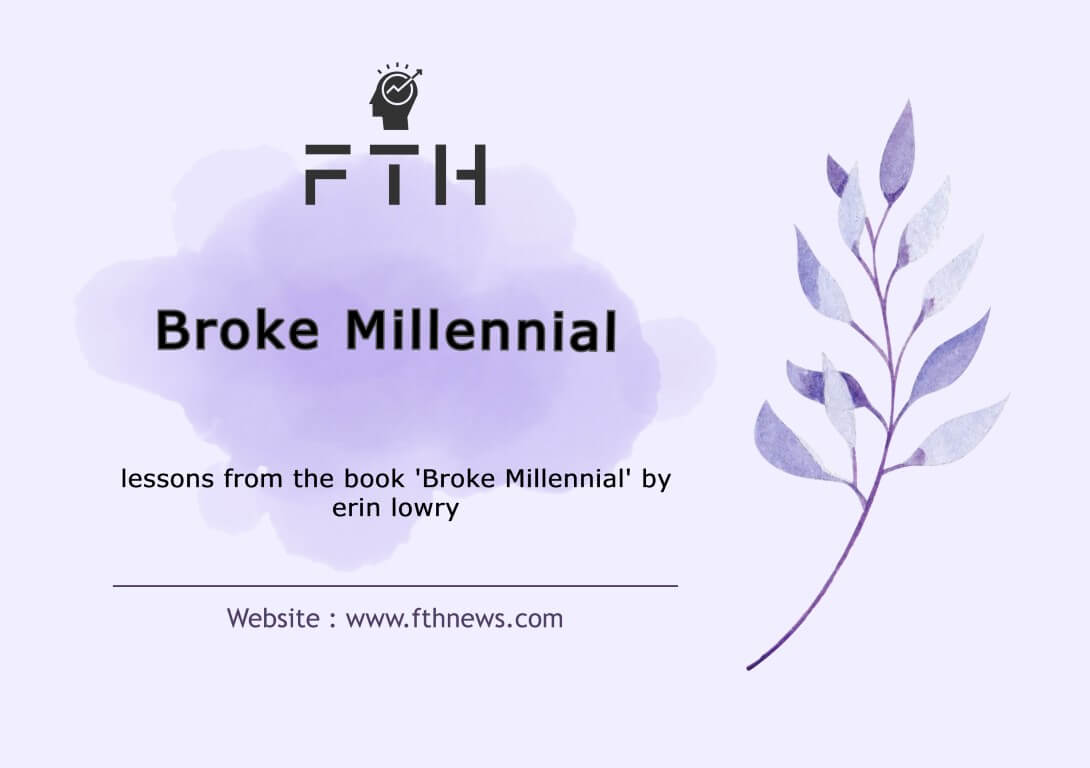
Broke Millennial: 8 Financial Lessons to Secure Your Future
Broke Millennial For many individuals who have recently graduated or are navigating their way through their thirties, financial matters can appear as a daunting challenge. Managing monthly bills can be challenging in itself, so how can one start saving money or contribute to a retirement fund? Achieving financial stability, much like any significant goal in life, necessitates taking meaningful steps. While these steps may seem simple, their impact is far-reaching.
In her book “Broke Millennial,” Erin Lowry offers essential insights tailored to cash-strapped individuals in their 20s and 30s. It addresses the common financial fears that many young adults share. The book aims to bridge the gap between financial frustration and financial satisfaction, as the inability to manage one’s finances can lead to the distressing inability to afford life’s necessities. The constant anxiety about money can take a toll on both your mind and body.
So, how can you break free from this anxiety trap?
The following lessons from “Broke Millennial” will reveal that understanding and managing your finances can be the key to escaping this cycle of financial anxiety. You don’t need complex financial formulas to improve your relationship with money; instead, you’ll find that a series of small, impactful steps can lead to significant changes.
Identifying Hidden Obstacles in Your Relationship with Money
Broke Millennial Changing your relationship with money doesn’t require mastering a complex science. Budget management and saving for the future are, in essence, straightforward concepts. But before you can embark on this Broke Millennial journey, you need to explore the roots of your financial behavior, which often trace back to your early years.
Money has been a part of your life since childhood, shaping your beliefs and habits. To address any compulsive behaviors around money, you must first revisit your upbringing. Start by reflecting on your childhood experiences and the attitudes toward money in your family. Did your parents openly discuss their financial situation, or was money a taboo topic spoken of with a closed mind? Perhaps you encountered financial struggles during your formative years, impacting your relationship with money. It’s quite likely that any negative money patterns you carry today can be traced back to your childhood experiences.
The path to financial freedom begins with unearthing these hidden obstacles. To do this, start by answering the following questions with honesty and jot down your responses for future reference:
- What are your earliest memories of money, and how do you feel about those memories?
- What were your sources of income as a child?
- What were the items or goods you purchased for yourself during your childhood?
Once you’ve recorded your responses, take a moment to analyze your money mindset. Do you worry about running out of money or being perpetually trapped in debt? If these concerns resonate with you, it’s indicative of a fear-based mindset. Continuing to handle money as you did in your childhood may perpetuate a cycle of financial helplessness.
By addressing the issues explored in this section, you’ll pave the way for more straightforward and effective steps on your journey to financial freedom.
Broke Millennial: Cash-Based vs. Tracking Every Dollar
Budgeting is a fundamental step on the path to financial control, but it’s not a one-size-fits-all endeavor. People have varied attitudes about money, shaped by their unique childhood experiences. Consequently, how you approach money management and the strategies that work best for you may differ from others, especially concerning your monthly income.
Cash Regime: One approach to budgeting is the cash regime. In a world dominated by digital transactions, you might wonder if this method still holds relevance. Well, it does, and here are two compelling reasons why:
Spending Control: Research indicates that people tend to spend less when using physical cash, such as coins and bills, compared to swiping credit or debit cards. The tangible nature of cash makes you more conscious of your spending.
Avoiding Fees: Additionally, managing your finances with cash can help you steer clear of costly transaction fees associated with electronic payments.Transitioning to a cash-only system may seem daunting, but it’s far from impossible.
To ease this transition, consider dividing your monthly budget into weekly installments. This way, you won’t need to stash an entire month’s worth of cash in your desk drawer.
Moreover, this approach allows you to closely monitor your expenses, providing greater control over your financial decisions.
By choosing the budgeting method that aligns with your financial habits and childhood influences, you’ll be better equipped to manage your money effectively and take strides toward financial freedom.
Broke Millennial: Track Every Dollar
Another effective budgeting method is meticulously tracking every dollar you spend. This approach involves recording each transaction in a dedicated spreadsheet, with columns for the date, item purchased, and the total cost down to the last dollar. While it may initially seem meticulous or extreme, this method offers invaluable insights into your spending patterns and can be a powerful tool for understanding where your income goes.
By diligently logging every expense, you gain a clear picture of your financial habits and where your money is flowing. This level of detail enables you to identify patterns and tendencies that may have previously gone unnoticed. With this knowledge, you can make informed decisions to optimize your capital allocation and manage your finances more efficiently.
While tracking every dollar may require extra effort and discipline, it is a valuable strategy for those who are determined to gain a comprehensive understanding of their spending habits and take control of their financial future.
Setting Realistic Budgeting Percentages for Long-Term Financial Success
To achieve your long-term financial goals, it’s crucial to establish realistic budgeting percentages that align with your unique circumstances and aspirations. In the world of personal finance, your expenditures typically fall into three categories: fixed expenses (like rent or mortgage), financial goals (such as savings and investments), and everyday expenses.
A widely recognized guideline for allocating your net income is the 50/20/30 rule:
Fixed Expenses (50%): Approximately half of your net income should be allocated to fixed expenses. These are the recurring costs that don’t fluctuate significantly, such as housing, utilities, and insurance.
Financial Goals (20%): Devote 20% of your income to financial goals. This category encompasses savings, investments, retirement contributions, and any long-term financial planning.
Everyday Expenses (30%): The remaining 30% is reserved for everyday expenses. These flexible costs include groceries, transportation, entertainment, and discretionary spending.
The key to success lies in being realistic about your income and adhering to these budgeting percentages. It’s important to remember that these guidelines serve as a framework, and as your life circumstances evolve, you can evaluate and adjust these percentages to better suit your specific situation.
While the exact terminology used for these categories might vary, what truly matters is that you’re actively managing your finances and striving to meet your long-term financial objectives. Allocating a disproportionate amount to fixed expenses, for example, might not be conducive to your financial well-being. Therefore, it’s advisable to ensure that your percentages are balanced and reasonable for your individual financial journey.
By following these guidelines and regularly reviewing your budget, you can make significant progress toward your long-term financial aspirations while maintaining financial stability in the present.
Boost Your Savings with Higher Interest Rates from Online Banks
When you look at your bank account balance, it might seem like the money is just sitting there, waiting to be spent. However, it’s essential to recognize that this money belongs to you, and it doesn’t have to remain stagnant in your account.
Banks make a substantial amount of money by using the funds you deposit. In return, they offer you interest in the form of an Annual Percentage Yield (APY). But the truth is, many of us didn’t select our banks based on the APY they offer. Often, we choose a bank because it’s the one our parents used, or it’s conveniently located near our home. However, the APY is a critical factor that can significantly impact your savings.
So, what type of bank typically offers the best APY? The answer: online banks.
Online-only banks, in general, provide much higher APYs compared to their brick-and-mortar competitors. Their cost-efficient operation is the key. Online banks don’t need to invest in physical branches, land, or pay property taxes, which significantly reduces their overhead costs. Consequently, they can pass on the benefits to their customers in the form of better interest rates.
Finding an online bank with the highest interest rate is as simple as conducting a quick online search. However, before making the switch, take the time to read the fine print regarding the bank’s fees and do some research on what other customers are saying about their experiences. This extra effort can help you make an informed decision and ensure you’re optimizing your savings potential with a high-yield online bank.
Broke Millennial: Credit Cards for Financial Success
Credit cards, often viewed with a mix of temptation and trepidation, can be a powerful financial tool when used responsibly. While it’s true that using a credit card can be an easy way to spend money, it also carries the risk of accumulating piles of bills and hefty interest payments if not managed wisely. So, should you steer clear of credit cards altogether? Not necessarily.
Credit cards have distinct advantages, particularly when it comes to building and maintaining your credit score. They can also prove invaluable when you need to secure a loan, such as for purchasing a home. The key is to adhere to some straightforward principles when wielding this financial tool.
First and foremost, never spend more with your credit card than you can comfortably afford to pay off in full by the end of each month. This practice ensures that you don’t accumulate interest charges and allows you to stay on top of your expenses.
Think of credit cards as a bridge between your monthly income and expenditures. When you use a credit card for purchases, the credit card company compiles these expenses over the course of the month and bills you at the end of the billing cycle. On the statement, you’ll encounter two crucial figures: the total amount owed and the minimum payment amount.
Paying the full amount by the due date clears your balance, and the credit card company won’t levy any additional charges. However, if you opt to pay only the minimum amount, the remaining debt carries over to the next month, subjecting you to interest charges. These interest rates can be onerous, often exceeding 20% per year, and credit card companies might have clauses that permit them to raise the rates even further if payments aren’t made promptly.
Broke Millennial: Saving to Avoid Debt
One essential change in your financial behavior that can significantly contribute to achieving financial stability is often summed up in this piece of advice from personal finance experts: “Pay yourself first.”
Instead of adopting the common approach of waiting until the end of the month to see if there’s any money left to save, make it a habit to set aside a portion of your earnings as soon as you receive your paycheck.
The rationale behind this practice is simple yet profound: life is inherently unpredictable. Saving money serves as a crucial safeguard against unexpected turns of fate. It’s a financial safety net that can help protect you when life takes an unexpected twist.
When you max out your credit card or accumulate debt to address emergencies, you end up paying interest on that debt rather than saving for your future. This can leave you in a more vulnerable position when another unexpected financial challenge arises.
So, how can you steer clear of the debt trap and build a safety net for your financial well-being? The answer lies in the power of small changes to create new habits. By consistently setting aside a portion of your income as soon as you’re paid, you gradually build the financial resilience needed to weather the storms of life and avoid the cycle of debt.
It’s these small yet deliberate changes in your financial behavior that can lead to lasting habits, ultimately helping you achieve financial stability and protect yourself against the uncertainties of life.
Emergency Fund to Your Financial Situation
The size of your emergency fund is a pivotal component of your financial preparedness. Being unprepared during the last financial crisis can make you more vulnerable to the next, emphasizing the importance of having an emergency fund that bridges the gap between your monthly paychecks.
But is saving alone sufficient to withstand financial crises? The answer isn’t one-size-fits-all.
Traditional financial wisdom suggests maintaining an emergency fund equivalent to at least six months’ worth of living expenses. However, it’s crucial to recognize that the ideal size of your emergency fund depends on your specific financial situation. For those dealing with substantial debt and a limited income, this rule might be out of reach in the short term.
Conversely, if you’ve managed to keep your debt manageable or you’re debt-free, aiming to cover six months’ worth of basic living expenses is a sound goal. Calculate your monthly expenses, including rent, bills, and groceries, and then multiply this figure by six to set your target.
For freelancers or self-employed individuals, the financial landscape is often more challenging due to income fluctuations and the absence of employer benefits. In these cases, it’s advisable to bolster your emergency fund further. Saving enough to cover nine months of living expenses can provide added security, recognizing the unpredictability of your financial situation.
It’s important to keep your emergency fund in a liquid, easily accessible account, preferably with an annual interest rate of at least 1%. While investments and stocks may offer higher potential returns, they lack the immediate liquidity and stability needed for emergency situations.
Your emergency fund should serve as your financial peace of mind, ready to support you during unexpected downturns and crises. By tailoring its size to your unique financial circumstances, you can better safeguard your financial well-being.














